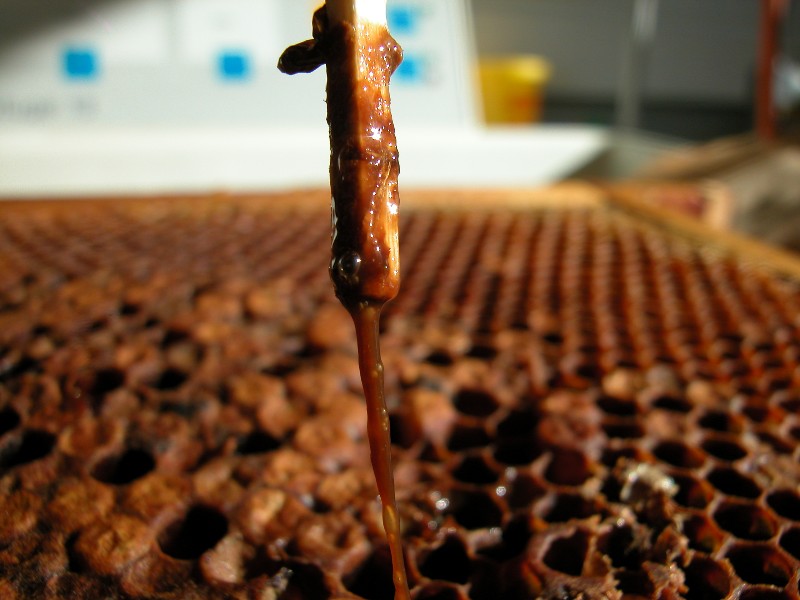Honeybee Diseases - American Foul Brood
American Foul Brood (AFB) is a serious, contagious notifiable bacterial disease of honeybee brood. The cause of AFB disease is a virulent spore-forming bacterium, Paenibacillus larvae var. larvae. AFB Spores can remain dormant for many years on hive and beekeeping equipment and in honey or wax. AFB can appear and spread quickly through a honeybee colony and result in the death of the colony in a short space of time. Note: It is the ability of the bacillus to spore that makes the AFB disease so resistant to disinfection. Any suspected incidence must be reported without delay.
Please download the latest Advisory Leaflet from the National Bee Unit, and AFB Info Sheet to obtain up to date information on detection and treatment methods.
Recognition
Image Courtesy The Animal and Plant Health Agency (APHA), © Crown Copyright

American Foul Brood, diagnosis using a matchstick and the ropiness test.
AFB symptoms include unusual sunken and perforated cappings, uneven brood pattern, and dead brood which have a sticky/slimy consistency and often an unpleasant smell. Suspect colonies should be reported immediately for inspection and testing by bee inspectors.
Detection
Hive Examination - Close examination of brood frames in spring and autumn is required to detect AFB. Bees should be gently shaken from the frames to allow full inspection, abnormalities are then easily spotted.
Checking Brood Pattern and Condition - Carefully examine the whole frame by holding it to the light and checking both sealed and unsealed brood for abnormalities such as unusual brood patterns, discoloured larvae, perforated cappings, or loose EFB scales in the cell (completely dried out larvae).
Uncapping Brood - Open any cells with abnormal looking cappings and check the consistency of any dead remains by probing with a matchstick (ropy - AFB, not ropy - EFB). Dispose of the matchstick into the lit smoker, do not disguard it as it will be infected.
Treatment
There is currently no approved treatment for AFB. Colonies which have been tested positive for AFB are destroyed by bee inspectors by burning in a pit on site along with the hive components.
Vectors
American Foul Brood (and EFB) can spread easily on its own. The bacteria can exist in beekeeping equipment, honey, wax, dead brood and can spread even quicker with the help of the beekeeper during normal hive / colony manipulations. The pathogens responsible for AFB & EFB can exist in a contagious state for long periods of time on infected hive components, equipment and materials.
- Beekeepers - Transferring contaminated equipment / material between hives, colonies and apiary sites.
- Robbing - Colonies weakened by AFB will fall prey to robbing, transferring spores to other colonies and apiaries.
- Drifting - As with Robbing will transfer spores to other colonies.
- Swarming - Swarms can carry the spores with them to new sites where the disease will spread once new brood is produced.
About the 'My Beekeeping Kit' website.
Contact Iain Dewar for enquiries, suggestions, corrections and contributions for improving the notes. Always welcome!